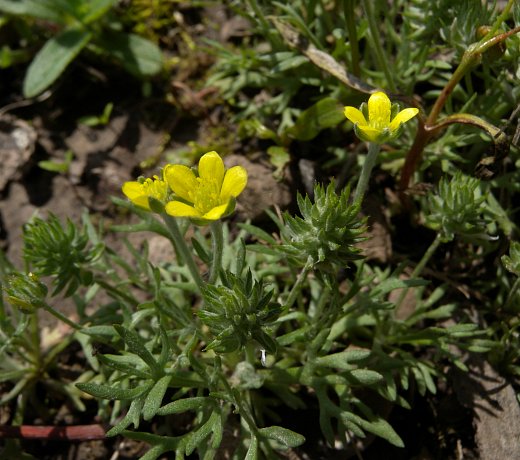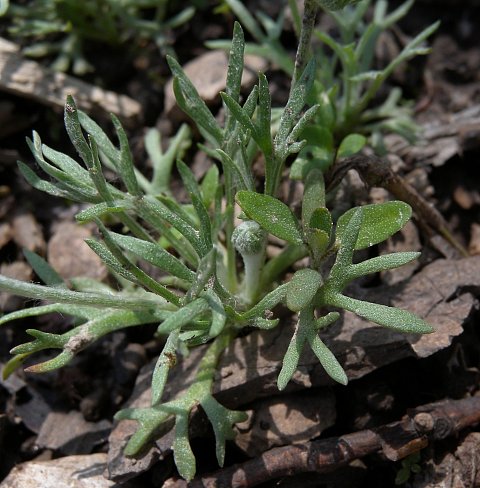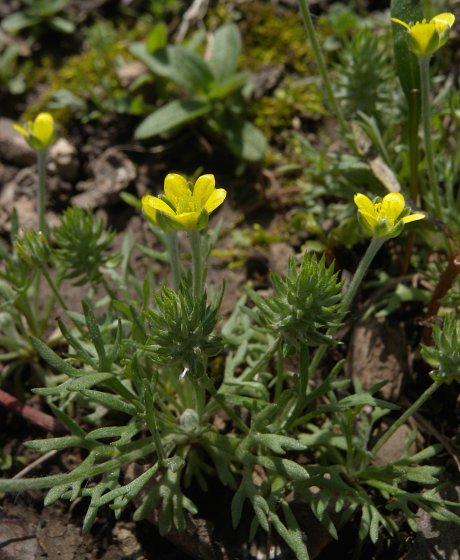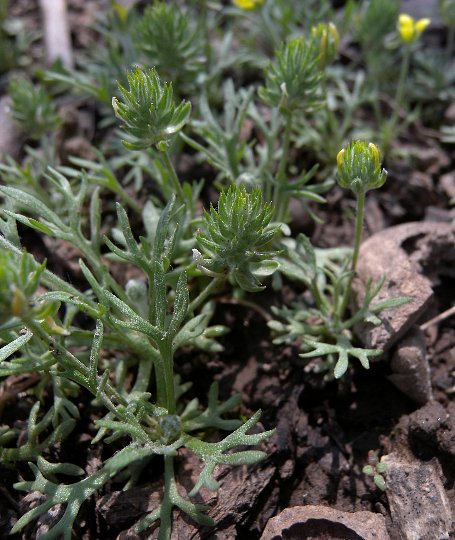
Each flower consists of 2-5 yellow petals, 5 pale green sepals, 5 or more yellow stamens, and a dense head of greenish yellow pistils. The petals are about the same length, or slightly longer than, the sepals. The sepals are lanceolate in shape and they are covered with white woolly hairs. The blooming period occurs during early to mid-spring, lasting about 3-4 weeks. Afterwards, the flowers are replaced by bur-like seedheads that are up to 12 mm. (0.5") long and 10 mm. (0.4") across; they have a prickly appearance because of the sword-like beaks of the achenes. Immature seedheads are pale green, but they later become light brown at maturity. The bodies of the achenes are about 2 mm. long, 2 mm. across, and flattened, while their beaks are 4 mm. long and slightly flattened. The root system is fibrous. Bur Buttercup reproduces by reseeding itself, and it often forms colonies of plants.

Cultivation: The preference is full or partial sun, mesic to dry conditions, and a barren soil that is sandy, gravelly, or compacted from trampling. This dwarf plant prefers open ground with little competition from other kinds of plants. The seeds require exposure to cold weather in order to germinate. Most growth and development occurs during the cool weather of spring. Drought tolerance is good.
Range & Habitat: Bur Buttercup is an uncommon weedy plant in Illinois. The webmaster found it growing at the picnic area of a park near Bloomington-Normal, Illinois (see Distribution Map). It has also been reported from NE Illinois. Bur Buttercup is native to SE Europe and central Asia. This plant was accidentally introduced into North America, where it is apparently more common in the western USA. For Illinois and other eastern states, typical habitats consist of campgrounds, picnic areas, and car lots in parks, particularly in areas where the ground is barren from too much trampling. In western USA, it also occurs in pastures and along roadsides. Highly disturbed areas are preferred.

Faunal Associations: Very little is known about this plant's relationships to fauna, except that its foliage is toxic to sheep and other mammalian herbivores. Like many other buttercups (Ranunculus spp.), the flowers of Bur Buttercup are probably cross-pollinated by small bees and flies. Aphids, sawfly larvae, and other insects are known to feed on buttercups, but these are mostly wetland and woodland species. The seedheads may provide a source of food to Ring-Necked Pheasants, Wild Turkeys, and other upland gamebirds. Because of the sharp beaks of the seedheads, it is thought that the seeds are distributed to new areas by human activities as they can cling to socks, blankets, and the canvas of tents. This is why Bur Buttercup is often found at camping sites and picnic areas at parks with natural areas. It also possible that the seedheads can cling to the fur and wool of mammals (e.g., sheep) and the feathers of birds, spreading the seeds into areas where these animals travel.

Photographic Location: A picnic area of a park near Bloomington-Normal, Illinois, where colonies of this plant were growing on barren ground underneath trees.
Comments: Other common names of this little plant are Hornseed Buttercup and Curveseed Buttercup. A scientific synonym is Ceratocephala testiculata, although most authorities retain this species in the Ranunculus genus. Because it is a relatively recent introduction to the state, Bur Buttercup (Ranunculus testiculatus) will probably spread to other areas of Illinois, however it appears to have a greater affinity for the dry climate of the western USA where precipitation is less than 30" (75 cm.) per year. Because of its dwarf size, distinctive prickly seedheads, and deeply divided leaves, Bur Buttercup is easily distinguished from other buttercups (Ranunculus spp.) in the state. It is also unusual in having flowers with as few as 2 petals, instead of the usual 5 petals.